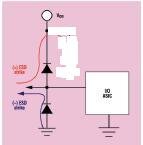xianweng
Member level 1
hi,everyone
how to choose diode area for ESD protection?For example ,if i want to pass HBM 2kV and the transient maximum 1.33A,how much area could withstand such a big current? Are there other factor should be considered when choose diode area?For example diode technology as below
Thanks any help in advance


how to choose diode area for ESD protection?For example ,if i want to pass HBM 2kV and the transient maximum 1.33A,how much area could withstand such a big current? Are there other factor should be considered when choose diode area?For example diode technology as below
Thanks any help in advance
